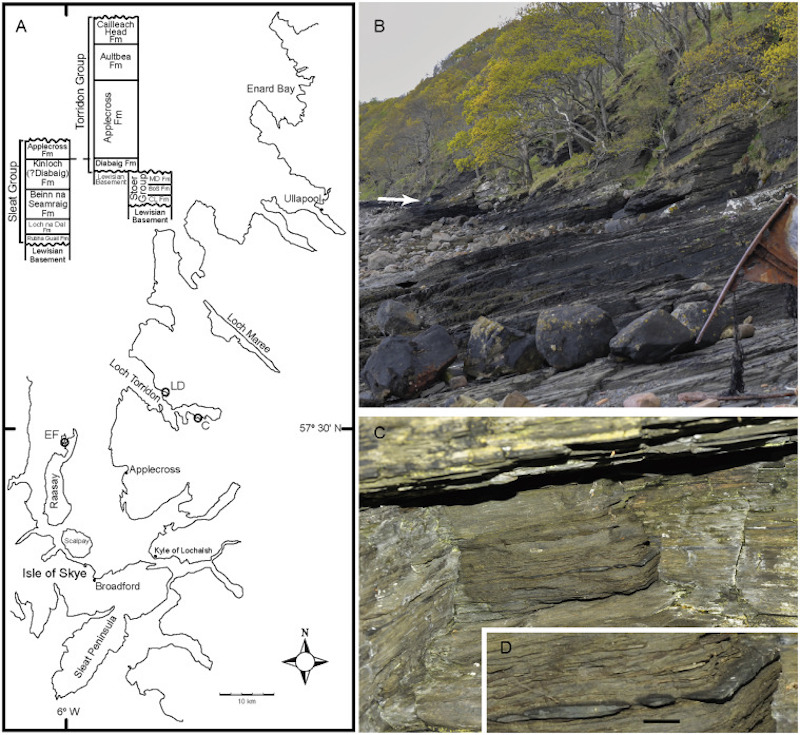
The beginnings of life on Earth billions of years ago, from simple single-celled organisms to more complex multicellular ones, is a widely accepted fact in science. But there are gaps or missing links in life’s timeline, as it’s known to science. In April 2021, scientists led by Paul Strother of Boston College reported on the discovery of new microfossils in ancient Scottish lake sediments that could help fill in the gap between the earliest single-celled life and multicellular life. These scientists say these microscopic fossils could be the oldest example of complex multicellular life in the evolutionary lineage leading to animals. They say the fossils are also significant because they come – not from ocean sediments – but from sediments of an ancient freshwater lake.
The peer-reviewed findings were published in the journal Current Biology on April 13, 2021.
The one-billion-year-old multicellular microfossils – Bicellum brasieri – were found in sediments that used to be at the bottom of Loch Torridan in Scotland’s northwest highlands. Co-author Charles Wellman of the University of Sheffield in the U.K. commented in a statement:
The origins of complex multicellularity and the origin of animals are considered two of the most important events in the history of life on Earth.
Our discovery sheds new light on both of these.



About Bicellum brasieri. Bicellum means “two-celled,” and brasieri is used to honor the late paleontologist and study co-author, Martin Brasier.
These fossils appear as tiny microscopic balls, each containing two different kinds of cells. The cells inside the ball are round and tightly-packed with thin cell walls. The outer layer or surface of the balls, however, are composed of longer, sausage-shaped cells that have thicker cell walls.
These fossils are clearly of multicelled organisms, the scientists say, albeit simple ones. But there’s an interesting puzzle. The fossils were found in ancient lake sediments, but most scientists think that multicellular life first began to appear in Earth’s primordial oceans.
The fossils were found in nodules of phosphate minerals. According to lead author Paul Strother, those nodules were:
… Like little black lenses in rock strata, about one centimeter [0.4 inches] in thickness. We take those and slice them with a diamond saw and make thin sections out of them.
Those very thin sections can then be studied under a microscope.
The researchers found multiple clumps of the Bicellum brasieri fossils, which all showed the same structure and organization regardless of their stage of development.

These fossils are extremely tiny, measuring only 0.001 inches (0.03 mm) in diameter. But when examined under powerful microscopes, the researchers noticed that the two kinds of cells in the balls differed both in shape and how and where they were positioned within the balls. Why is that significant? As Strother told LiveScience.com:
That’s something that doesn’t exist in normal unicellular organisms. That amount of structural complexity is something that we normally associate with complex multicellularity.
This raises more questions. What type of organism is Bicellum brasieri? The scientists still don’t know for sure, but they don’t think it is a kind of algae, since the round cells don’t have rigid walls. Bicellum brasieri might instead have been a type of Holozoa, which includes both multicellular animals and single-celled organisms. Holozoa can include animals and their closest single-celled relatives, but it excludes fungi.
Due to constant geological processes on our active planet, there aren’t a lot of fossil records left from the very earliest life on Earth. The oldest known fossils of microbes are about 3.5 billion years old. That’s fossils of the microorganisms themselves; other fossils associated with microbes are known to be up to 3.7 billion years old. These include sediment ripples on an ancient seafloor in Greenland and hematite tubes in volcanic rock in Quebec, Canada.

Scientists have thought that the earliest microscopic life forms originated in the oceans because that is where most ancient fossils have been found, in marine sediments, as opposed to sediments in freshwater lakes. Strother explained:
There aren’t that many lake deposits of this antiquity, so there’s a bias in the rock record toward a marine fossil record rather than a freshwater record.
But the discovery of Bicellum brasieri now throws a wrench into that hypothesis. It shows that the transition from single-celled microbes to multicellular ones could also have occurred in lakes, despite the fact that lakes are more greatly affected by changes in temperature and alkalinity. According to the researchers, those factors may even have helped evolution to proceed more quickly in such freshwater habitats.
The findings show that the emergence of multicellular organisms may have occurred in more than one kind of aquatic environment, not just oceans as previously thought. That may also be good news for the Perseverance and Curiosity rovers on Mars, both of which are currently exploring sediments and rocks that used to be at the bottom of lakes a few billion years ago. Perseverance in particular is specifically searching for evidence of ancient microbial life. If life on Earth evolved in both oceans and lakes, could the same thing have happened on Mars?

Bottom line: Newly-discovered microscopic “ball” fossils in ancient lake sediments in Scotland suggest that life may have evolved from single-celled organisms to multicellular life in lakes. Until now, scientists have thought that this key transition in evolution likely only occurred in oceans.
Source: A possible billion-year-old holozoan with differentiated multicellularity
Find out more about the discovery on this webpage from Paul Strother











